The evolution of the nuclear triad: prospects for the development of the aviation component of the strategic nuclear forces of the Russian Federation
The historically most important components of the Strategic Nuclear Forces (SNF) of the USSR and then of the Russian Federation have always been Strategic Missile Forces (Strategic Rocket Forces). As we reviewed in the previous material, Strategic Missile Forces may well effectively carry out nuclear deterrence even in the event of an enemy sudden disarming strike and full deployment of a missile defense system. Nevertheless, there are still aviation and marine components of the nuclear triad. In this article, we consider the prospects for the development of the aviation component of the strategic nuclear forces.
Air component of strategic nuclear forces
We considered in detail the capabilities and effectiveness of the air component of the strategic nuclear forces in the article Sunset of the Nuclear Triad? Air and ground components of strategic nuclear forces. Based on the results of the analysis, we can say that the aviation component of the strategic nuclear forces is currently practically useless from the point of view of deterring the United States. A long reaction time does not allow carriers (strategic bombers) to avoid defeat at aerodromes during the enemy’s delivering a sudden disarming strike. Weapon strategic bombers, cruise missiles (CR), are extremely vulnerable to fighter aircraft and enemy air defense systems.
Thus, we can say that the existing and promising strategic bombers of the "classical" design are absolutely useless as a tool of nuclear deterrence, provided that the enemy makes the "first move". Moreover, they are quite effective as a weapon of the first strike, taking into account some of the shortcomings, which we will discuss below. Even more strategic missile bombers are effective as strategic weapon of conventional forces.
Could a strategic bomber be created capable of effectively solving the tasks of nuclear deterrence in the presence of the possibility of an enemy delivering a sudden disarming strike? Theoretically, this is possible, but such a product should radically differ from traditional aircraft.
Aircraft systems of constant readiness
First of all, the carrier should be constantly ready for launch within three to five minutes after receiving a warning about a missile attack. That is, it should be something like an intercontinental ballistic missile in a container: an airplane in a closed hangar, with direct access to the runway. After an alarm, the duty pilots take up seats, the tunnel to the cockpit is cleaned, emergency take-off, possibly at rocket boosters, and departure from the airfield based at least several tens of kilometers. In case of cancellation of the launch, a return to the airfield and re-preservation in the hangar are carried out.
The weapon of such a carrier should not be cruise missiles, at least subsonic, at least hypersonic, but intercontinental ballistic missiles with an air launch. As such, a modification of the YRS intercontinental ballistic missile, the mass of which is about 46-47 tons, which is quite acceptable for a carrier aircraft, can be considered. Accordingly, the range of ICBMs with an air launch should ensure the possibility of hitting targets in the United States when launched from the basing area.
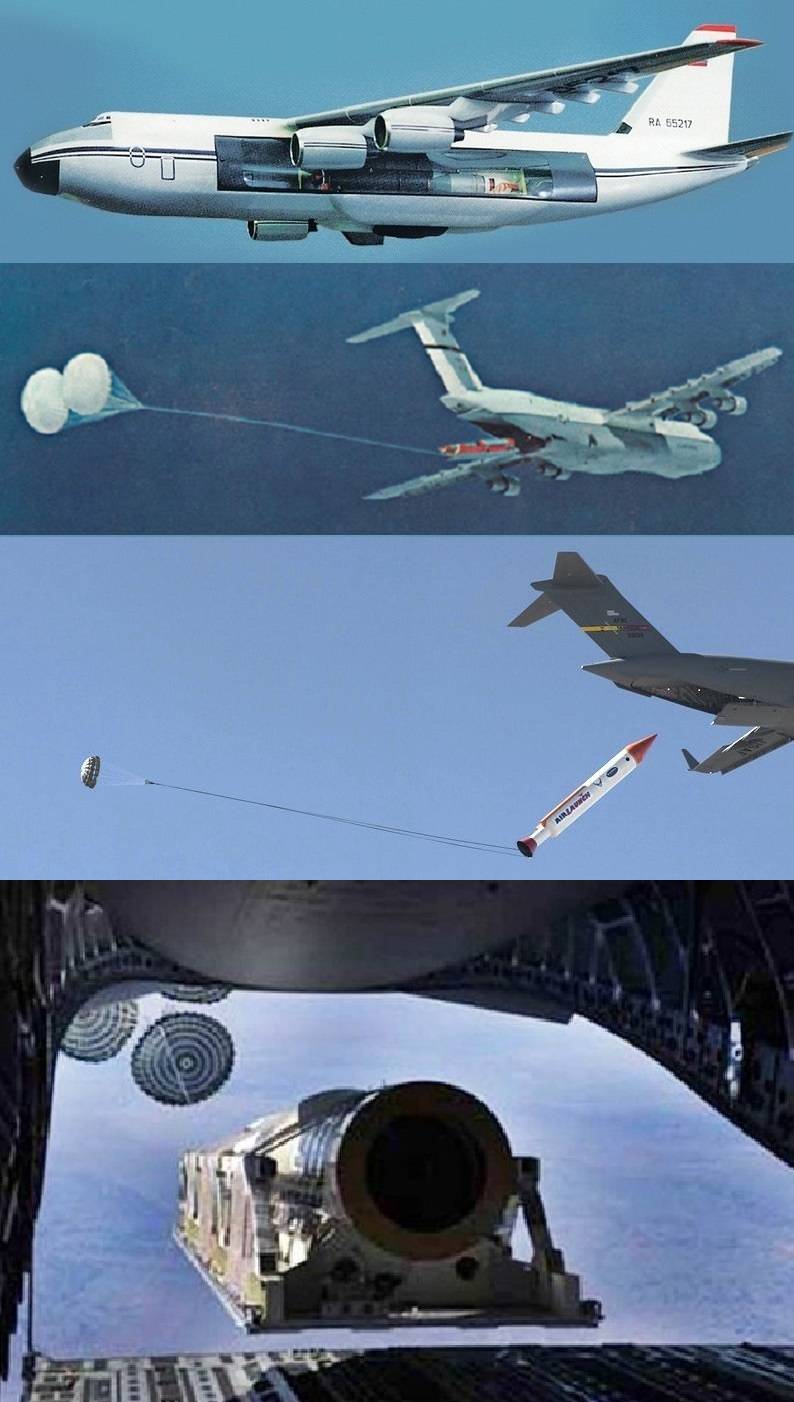
Air-launched ballistic missile launch
The carrier is an “oak” construction, something like B-52 with its unrealistically long life cycle and excessive strength of hull structures, uneconomical, but reliable engines.
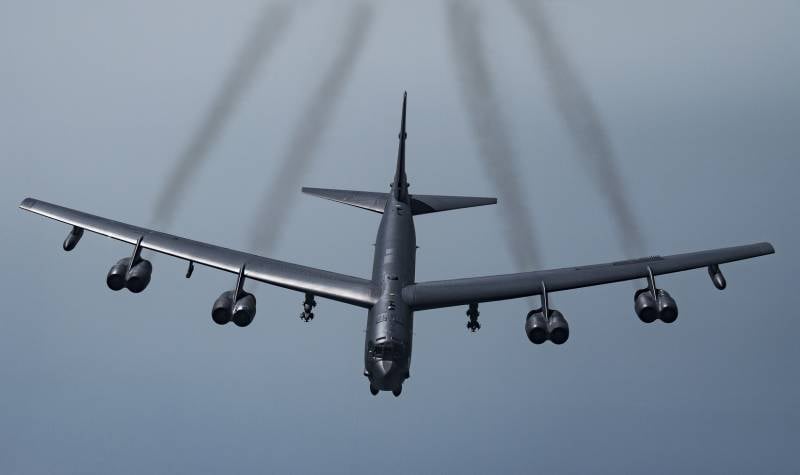
The life of the B-52 bomber exceeds the life of many warships. The reason for its survivability was largely due to the huge margin of safety of the structure, high maintainability and relatively low cost of operation
What are the advantages of such a system? The reaction time is comparable to launching an ICBM from the mine, there is no need for the carrier to leave the borders of the Russian Federation, and it is possible to cancel the launch after launch. In the case of an initial warning of a missile attack, even the slightest suspicion, carriers can start immediately, even before the information about the attack is confirmed, in order to leave the affected area. If the information is not confirmed, the carriers simply return to the airfield, go through maintenance and take their place in the hangar.
The main problem of constant readiness aviation systems is that it is necessary to create and ensure the synchronous operation of the aircraft itself, ICBMs and all associated infrastructure - emergency take-off in any weather, constant readiness of equipment and pilots. How difficult, expensive, and generally possible, difficult to assess. How will the ICBM behave after several take-off and landing cycles? The adversary can play on the verge of a foul, causing the take-off of carriers and wasting their resource, and then deliver a real blow during the passage of carriers or a missile maintenance.
In addition, it is necessary to understand that due to the need to ensure emergency take-off and to be in constant readiness, such complexes will be extremely highly specialized, no multifunctional application - everything is just like with the Topol or Yars mobile complexes.
Are the strategic nuclear forces and the air forces of the Russian Federation ready to create such weapons? If so, what should be the number of such media? Given the novelty and narrow specialization, it is unlikely that it will be possible to build them in quantities of more than 10-20 units, especially given the need for collateral support - special hangars adjacent to the runways intended only for them. If there are one or three nuclear warheads (YaBCh) on one air-based ICBM, this will be a total of 10-60 warheads.
The above allows us to consider that in the context of resistance to a sudden disarming strike, the aviation component of the strategic nuclear forces is practically useless, and this cannot be changed. The development of aviation systems of constant readiness is likely to be a complex and economically expensive task with a large number of technical risks.
So, the aviation component of strategic nuclear forces can be written off?
In addition to the task of nuclear deterrence of the enemy by delivering a guaranteed retaliatory strike, the strategic nuclear forces of the Russian Federation can and should be assigned the task of exerting continuous pressure on the potential enemy. That is, the aviation component of the strategic nuclear forces should be used to create an unpredictable threat, the repulsion of which will require significant funds from the enemy, which, in turn, will reduce its offensive capabilities due to the inevitable finiteness of any resources: financial, technical, human.
Unpredictable threat
To some extent, existing strategic bombers are suitable for solving this problem: Tu-95, Tu-160, promising PAK-DA. Nevertheless, for the most effective implementation of the task of creating threatened situations to the enemy, the design and armament of promising aviation systems of the strategic nuclear forces of the Russian Federation must meet certain requirements:
- Firstly, the main requirements for a promising strategic bomber-missile carrier should be minimizing the cost of flight hours and maximum reliability. Everything else - speed, inconspicuousness and other things a second time;
- secondly, the existing cruise missiles with nuclear warheads as the main weapons of strategic bombers can hardly be considered an effective solution. Due to the subsonic speed of flight, they can be intercepted by almost any means of air defense (AA), as well as by enemy fighter aircraft. Hypersonic missiles will most likely have a limited flight range, which will require missile-carrying bombers to reach the borders of their launch beyond the state border of the Russian Federation, where they (carriers) can also be destroyed by air defense and enemy fighter aircraft.
Based on this, the most effective weapon for promising missile-carrying bombers can be air-launched air-launched ICBMs, which we previously considered in the context of constant readiness in aviation systems. The missile design can be largely unified with the promising ICBM for the ground component of the strategic nuclear forces.
Given the dimensions of existing and prospective ICBMs, their placement on traditionally designed missile-carrying bombers may be difficult or even impossible. The best option is to create a missile carrier aircraft based on one of the modifications of the IL-76, or on the basis of a promising transport aviation aircraft (PAK TA).
The length of the existing Yars ICBM is about 23 meters with a mass of about 47 tons, which is already quite acceptable for a transport aircraft. The estimated length of the promising missile 15Zh59 of the Courier complex should be about 11,2 meters, with a mass of about 15 tons.
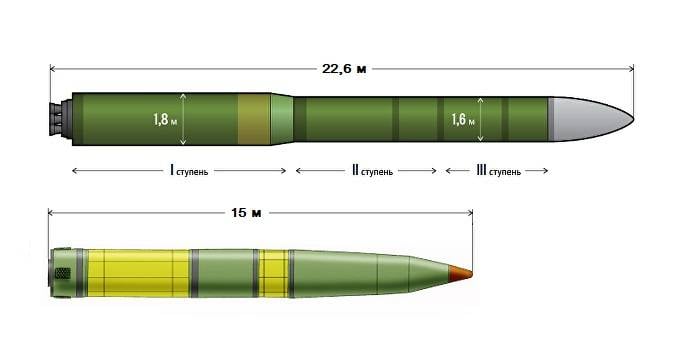
The approximate dimensions of the Yars ICBM and the promising ICBM 15Zh59 of the Courier complex
The maximum carrying capacity of the IL-76MD is 48 tons, and the IL-76MD is 60 tons. In the modification of IL-76MF, the length of the cargo floor is increased to 31,14 m, the flight range of IL-76MF with a load of 40 tons is 5800 km. The capacity of the latest modification of the IL-476 is 60 tons, the flight range with a load of 50 tons is up to 5000 km.
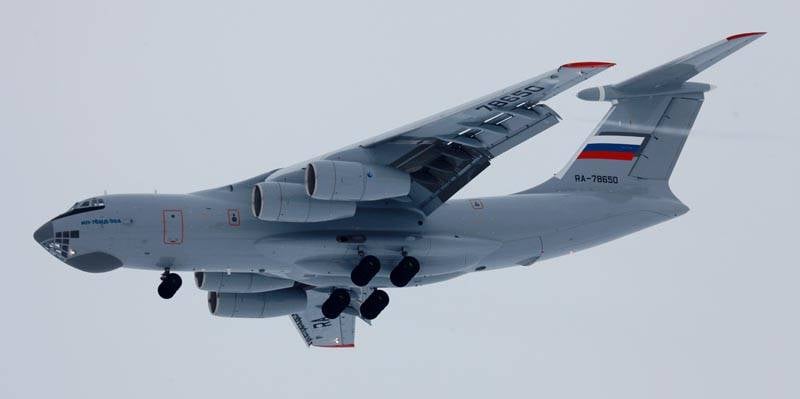
IL-476. Photo: Alexey Mikheev, take-off.ru
PAK TA with an estimated carrying capacity of about 80-100 tons may have even greater possibilities for deploying air-based ICBMs.
Thus, a promising missile-ballistic aviation complex (PAK RB) based on a modified IL-476 can carry one aviation-based ICBM, and a PAK RB based on the PAK TA (possibly) two aviation-based ICBMs.
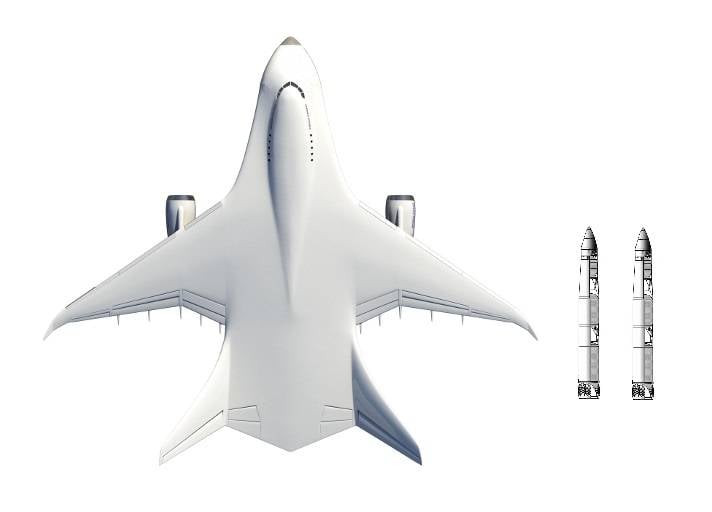
PAK RB based on PAK TA may become the carrier of two air-based ICBMs
An important problem that will need to be solved when creating the PAK RB is the possibility of carrying out multiple take-offs and landings of the carrier aircraft with ICBMs on board. Most likely, it will be something like a complex computerized system of dampers, with active suppression of shock, vibration and vibration over a wide range.
What is the difference between the PAK RB and the previously considered aviation readiness complex? In the absence of the need to ensure constant duty on the ground, in minute readiness for launch, in the absence of requirements to strengthen the structure for emergency take-off. Also, during the operation of the PAK RB, the existing infrastructure and airbases of strategic bombers should be used, there is no need for dedicated bands for each aircraft. The operation of the PAK RB itself should be carried out in the normal mode for aircraft of this type.
Is the creation of the PAK RB real? Yes, it’s quite possible to create such a complex. This is confirmed by research and testing in this direction conducted by the USSR and the USA during the years of the Cold War. The Makeeva mall considered the possibility of creating the Air Start complex on the basis of the An-124 aircraft and a rocket with a liquid rocket engine. Do not forget about the success of private astronautics in this direction.
NASA's Pegasus Rocket Launch
In what quantities should PAK RB be built? Presumably, their number should be comparable with the number of existing strategic missile-carrying bombers, that is, be about 50 units. Accordingly, the number of warheads will be 50-150 nuclear warheads for the PAK RB based on the Il-476, or 100-300 nuclear warheads for the PAK RB based on the PAK TA.
Can the PAK RB be used as a carrier for cruise missiles with nuclear warheads? Yes, moreover, RCs with nuclear warheads are more likely to be placed on the PAK RB in a larger quantity than on classic design missile-carrying bombers, especially with regard to the PAK RB version based on PAK TP.
In the cargo compartment of the PAK RB on the basis of the IL-476, approximately 18 missiles of the X-102 type or their non-nuclear version of the Kh-101 can potentially be placed (mass of 18 missiles without a launcher 43,2 tons). In turn, the PAK RB on the basis of PAK TA could potentially carry about 36 missiles of the X-101 / X-102 type (mass of 36 missiles without a launcher of 86,4 tons), which is already comparable to the ammunition of a “frigate” warship or multipurpose nuclear submarine (ICAPL) of the "Ash" type. KR discharge can be carried out from special cartridge-type containers, by analogy with the discharge of ICBMs.
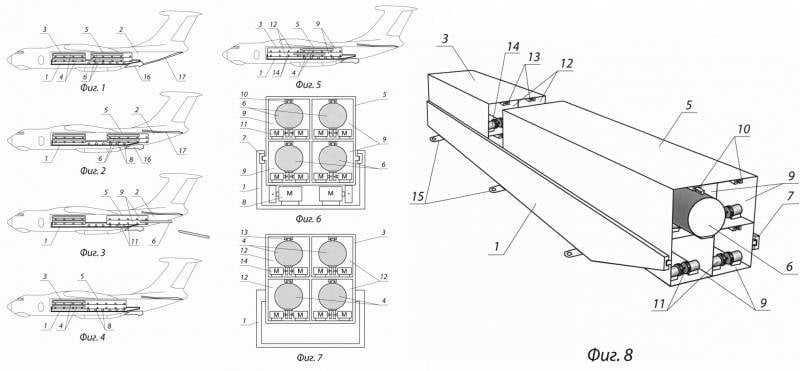
Images from the patent for “Device for the transportation and dumping of cargo for a transport aircraft”
Thus, the PAK RB can be used as an effective carrier of high-precision non-nuclear weapons - an element of the Strategic Conventional Forces. Whether this will be one modification of the PAK RB with a variable load in transport launch containers (TPK), or it will be necessary to create separate modifications for air-based ICBMs and for the Kyrgyz Republic, the question is open, but, most likely, the creation of a single version of the PAK RB is possible.
How expedient is the creation of a PAK RB on the basis of transport aircraft? Perhaps it is better to create specialized bombers of a classic design? Creating specialized aircraft of this type will cost much more than developing a modification of the IL476 or PAK TA. The range of missile weapons is such that entering the anti-aircraft defense zone or fighter aircraft is no longer required, and bombing is possible only against an enemy who has no anti-aircraft defense in principle, even if the carrier is “invisible” even “hypersonic”.
The Russian Air Force urgently needs a large fleet of transport aircraft, which is the cornerstone of the mobility of modern armed forces. In addition, we need refueling aircraft, early warning aircraft, and other auxiliary aircraft, which are built on the basis of transport aircraft. Perhaps, on the basis of the IL-476 or PAK TA will be built aviation combat laser complex (ABLK) "Peresvet-A". In this sense, the development of the PAK TA and the further modernization of the IL-76 (or the creation of a new aviation complex to replace it) have a much higher priority than the creation of the PAK DA - the "classic" bomber-bomber. The construction of PAK TA and / or IL-476 in a large series, in many unified modifications, will significantly reduce the cost of an individual machine.
Are strategic classic-design missile bombers needed then? Is there a niche for them? Yes, such machines can and will play an important role as a conventional weapon. But the very essence of such machines will change significantly, most likely, these will not be strategic bombers, but multifunctional aircraft capable of hitting ground, surface, air targets, and possibly targets in near space. However, this is a topic for another discussion.
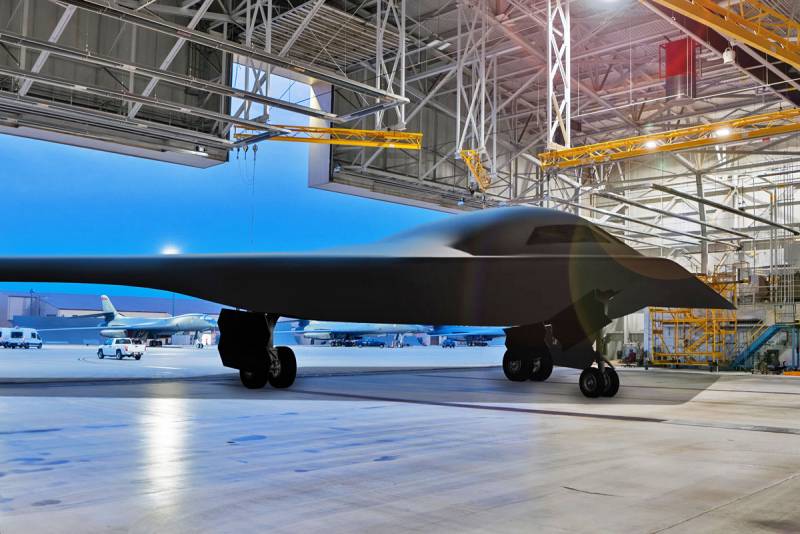
Perhaps the B-21 Raider will be the first multifunctional bomber equipped, in addition to air-to-ground weapons, also air-to-air weapons, laser weapons
Conclusions
1. The aviation component of the strategic nuclear forces is unsuitable for nuclear deterrence in the context of the possible US launch of a sudden disarming strike. Even if it is theoretically possible to realize complexes that can provide continuous duty on the ground and take off a minute after receiving a command, in practice their implementation can be fraught with both technical difficulties and significant financial costs.
2. Nevertheless, the aviation component of the strategic nuclear forces can be an important element of strategic deterrence designed to exert continuous pressure on a potential enemy using the uncertainty of the location of carriers and their combat load.
3. As a carrier of nuclear weapons for the aviation component of the strategic nuclear forces for the period from 2030 to 2050, a promising missile-ballistic aviation complex - PAK RB based on the Il-476 transport aircraft or PAK TA can be considered.
4. The main weapon of the PAK RB should be an air-launched ICBM with air launch, as much as possible unified with a promising solid-fuel ICBM for promising mine and mobile ground missile systems (PGRK).
5. In addition to air-launched ICBMs, existing and promising cruise missiles with nuclear warheads, which are currently the main weapons of strategic bombers, and also promising hypersonic air-launched missiles with nuclear warheads, can be used on the PAK RB.
6. Significant volumes of internal compartments and a large carrying capacity of transport aircraft allow you to take on board large volumes high-precision cruise, hypersonic or aeroballistic missiles with non-nuclear warheads, which will make the PAK RB an important element of the Strategic Conventional Forces.
7. The shorter range of the PAK RB, implemented on the basis of a transport aircraft, in comparison with existing and promising classic-design bombers, is compensated by the longer range of weapons, which should be about 8000-10000 kilometers for air-launched ICBMs. The range of existing cruise missiles is about 5500 kilometers and can be increased in promising weapons of this type.
8. Promising air-based ICBMs should provide the ability to strike on a gentle trajectory with a minimum launch range of about 2000 km or less in order to put pressure on the enemy with the threat of a sudden decapitation strike on him.
9. An important advantage of the PAK RB will be its ability to disguise among a huge fleet of military transport and auxiliary aircraft, made on the basis of aircraft of a similar type. In fact, it will be something like a PGRK disguised as a cargo van, only in the air. If now the US Air Force and NATO are forced to react to the appearance of Russian strategic bombers in the air near their territory, then if the PAK RB is created, they will have to react similarly to all aircraft of the military transport and auxiliary aircraft of the Russian Federation, which will lead to an increased load on their Air Force , reducing the resource of fighter aircraft aimed at intercepting, increasing the fatigue of personnel, significantly complicating the work of intelligence.
10. The estimated number of PAK RB should be about 50 units. Depending on the selected source aircraft, IL-476 or PAK TA, the total number of air-based ICBMs can be about 50-100 units, respectively, the number of nuclear warheads deployed on air-launched ICBMs can be about 50-300 units, in depending on the type of warhead (monoblock or separable). The total number of cruise missiles in nuclear or non-nuclear equipment can be about 900-1800 units when placed on the PAK RB instead of aviation-based ICBMs.
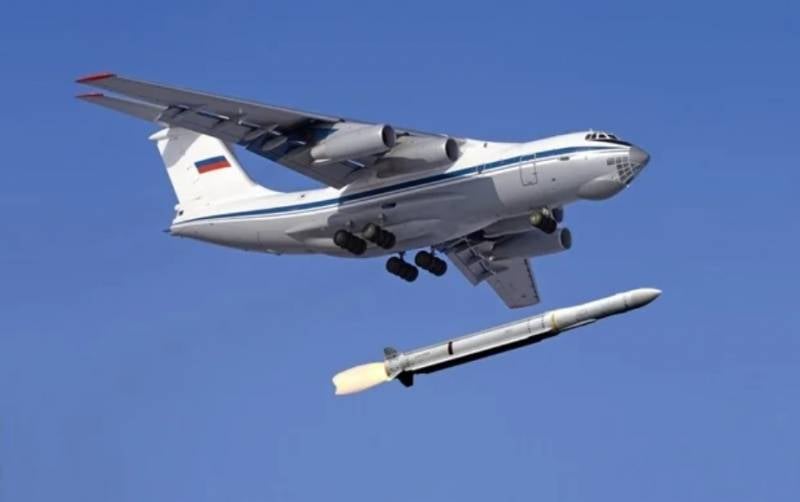

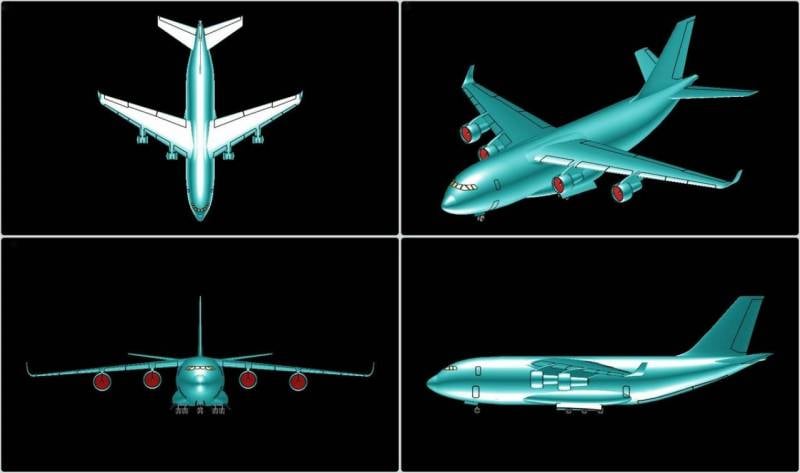
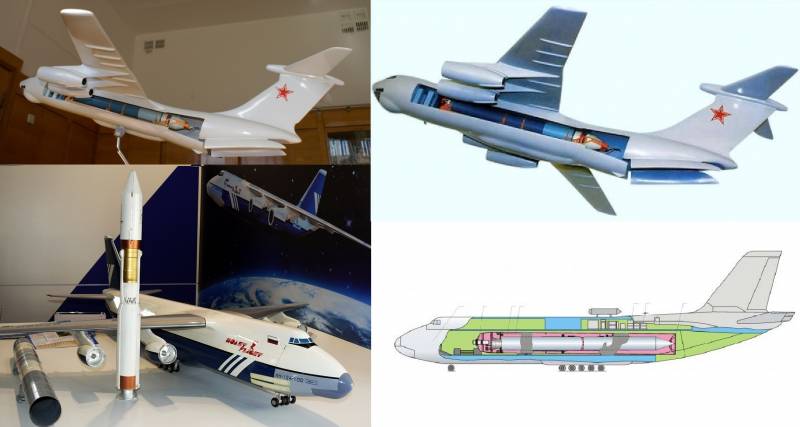
Information